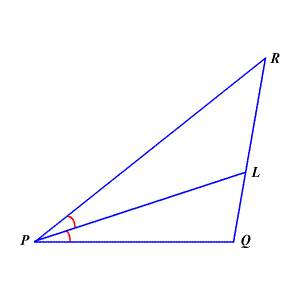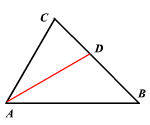Angle Bisector Theorem
Warning: This name is used differently in different textbooks. In some textbooks, it refers to the theorem which states that any point on an angle bisector is equidistant from the two sides of the angle.
What most textbooks call the Angle Bisector Theorem is this:
Anangle bisectorin a triangle divides the opposite side into two segments which are in the same proportion as the other two sides of the triangle.

In the figure above,bisects, so.
Triangle Angle Bisector Theorem
Anangle bisectorof an angle of a triangle divides the opposite side in two segments that are proportional to the other two sides of the triangle.

By the Angle Bisector Theorem,
Proof:
Draw.
Extendto meetat point.

By the Side-Splitter Theorem,
---------(1)
The anglesandare corresponding angles.
So,
Sinceis a angle bisector of the angle,.
By theAlternate Interior Angle Theorem,.
Therefore, by transitive property,.
Since the anglesandarecongruent, the triangleis anisosceles trianglewith.
Replacingbyin equation (1),
Example:

Find the value of.
By Triangle-Angle-Bisector Theorem,
.
Substitute.
Cross multiply.
Divide both sides by.
The value ofis.




